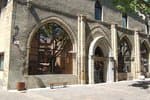Lac du Siguret
6 points of interest
 History
HistoryVintage swather rake
This vintage farm implement was horse-drawn. The farmer sat on the iron seat. Its teeth form a kind of rake and its purpose was to pile up the hay in rows (known as windrows).
 Lake
LakeLac du Siguret
This stretch of water is a vestige from the last ice age 6,000 years ago. At category 2 lake, it is home to pike, carp and trout. The site was listed in 2012 as a Sensitive Natural Area of the Hautes-Alpes. An inventory study was commissioned by the municipality of Saint-André d'Embrun in collaboration with the regional conservatory for natural areas, CEN PACA, and its results showed significant diversity, with 350 species of plants, 110 species of insects and 52 species of birds. Vernacular heritage
Vernacular heritageRuins
This ruin used to be a house. A window can still be seen on the side. Today, it has been covered by vegetation and some parts are virtually invisible. Other ruins can be seen along the route of the trail. Dry-stone walls are present. Some of them, around the edges of the fields, are enclosure walls. While others are retaining walls. These are called restanques in Provence. They were built in sloping areas to create crop terraces, holding back the earth. Fauna
FaunaGraellsia isabellae or Spanish moon moth
This species is also called the stained glass moth. The upper side of its wings is green, with very dark outlines. Its antennae are unusual, in the shape of a brush. In the Department of Hautes-Alpes, the species is primarily found in the mountain pine forests. It tends to be active at dusk. During the breeding season (April-June), the female releases sex pheromones when the temperature rises above 13°C. Her eggs are spherical in shape and are 2 to 3 mm in diameter. Flora
FloraReed bed
Reed beds are officially recognised in France as natural zones of ecological interest in terms of fauna and flora. They are a true reservoir of biodiversity for avifauna (birdlife). This unique environment is protected. They are areas on the edges of pools and marches where reeds constitute the primary vegetation. Reed beds harbour the nests and broods or numerous marsh-dwelling birds and they are effective water purifiers, limiting water pollution. In addition, the species can withstand temperatures down to -20°C. Flora
FloraAstragalus centralpinus - Milkvetch
This endangered species can reach 1 metre in height. Its enormous clusters of yellow and brown flowers can be seen during its flowering period, April to June. If the plant has been grazed or mown, there may be a second very late flowering on the remaining plant in September. In the Alps, there a various habitats favourable to the species, which colonises wide open areas in particular.
Description
From the car park, go left onto the track leading to the « chemin du Lauzerot » sign.
- Then take the uphill track on the right following the "Chemin du Lauzerot". Keep left on the narrow track which runs along the edge of the fields and continues uphill along the forest edge. At the next intersection, near the field, take the track on the left.
- After a few hundred metres, turn right and continue down the hairpin bend.
- When you come to a ruined house, turn left at the intersection.
- Follow the path and when you reach the intersection among the fields, turn right. Follow the track until you come to another intersection. Then turn left. Stay on this track and go past the bend. After the bend, turn right onto the path running downhill to the lake. Pass the area of small boulders and the stream and continue straight ahead after the bench.
- Take the next track on the left which leads to the chapel of St-Roch. Go past the chapel and continue straight ahead on the track which leads down to the road. Turn right onto the road which brings you back to the car park.
- Departure : Lac du Siguret
- Arrival : Lac du Siguret
- Towns crossed : Saint-André-d'Embrun
Altimetric profile
Recommandations
Bathing is permitted, but is not supervised. 
Fishing is also permitted on the Lac du Siguret.
Information desks
Tourist office Embrun
Place Général Dosse - BP 49, 05202 Embrun
October to march : Monday to Saturday, 9.00 - 12.30 & 13.30 - 17.00.
April, may, june & september : Monday to Saturday, 9.00 - 12.30 & 14.30 - 18.00
July and August : Monday to Saturday, 9.00 - 19.00. Sundays, 10.00 - 12.30 & 16.00 - 19.00
On French national holidays (except 14th of July and 15th of August) : 9am to 1pm. Closed on the 1st of January, 1st of May, 25th December and 11th November
Closed on Thursdays outside French holidays’ periods
Transport
Public transport >>{"Rando Pays des Ecrins"}
Access and parking
Accessibility
More information
Source

Report a problem or an error
If you have found an error on this page or if you have noticed any problems during your hike, please report them to us here:
